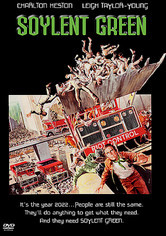Soylent Green-1973
Director Richard Fleischer
Starring Charlton Heston, Leigh Taylor-Young
Scott’s Review #943
Reviewed October 8, 2019
Grade: B
Soylent Green (1973) is a rather obscure offering starring then big-named star Charlton Heston in a dystopian science-fiction film.
The story is futuristic and eerily reminiscent of Planet of the Apes (1968), though not nearly as compelling nor as layered.
The result is admirable for its progressive message, cool colors, and sets, but feels dated and of its time and treats female characters more like props than characters, leaving an uneven result.
It’s a one-and-done sort of film.
The year is 2022 and because of the Industrial Revolution, forty million people live in New York City, suffering year-round from extreme humidity because of the greenhouse effect and shortages of water, food, and housing.
Only the wealthy are afforded necessities and residents of the rich (mostly female) are referred to as “furniture” and used as slaves.
Detective Frank Thorn (Heston) is tasked with investigating the murder of an affluent and prominent man, which leads him to dire details surrounding Soylent Industries and the food they produce.
The film seems like someone’s visionary idea turned Hollywood.
Loosely based on a 1966 novel entitled “Make Room! Make Room!” by Harry Harrison, Heston is cast as the lead while his career was slowly declining, but he is still the star and quite hunky for an older gentleman.
He plays a role similar to the character of George Taylor in Planet of the Apes, especially during the final climactic reveal, which will make viewers question what is contained in what they are eating for dinner.
Heston carries the film well and mixes wonderfully with character actor Edward G. Robinson, who plays Sol Roth in his final role. The old character decides to “return to the home of God” and seeks assisted suicide at a government clinic.
The final scene between the actors is poignant and heartfelt as they say goodbye to each other. Eagle-eyed viewers will spot a young Dick Van Patten in a tiny role during this scene.
Any romantic chemistry is lacking in Soylent Green as a potential love match between Frank and Shirl (Leigh Taylor-Young) strikes out. Mismatched and having little thunder together, the couple does not appeal well.
Making matters worse is that Shirl is mere “furniture” limiting the character’s potential. She is reduced to assisting with Frank’s investigation.
The main detraction is that the film does not feel very futuristic or authentic. The characters look like actors from the 1970s dressed up to look like they are from the future always with a tint of Hollywood thrown in.
The story loses its way halfway through and teeters about between pure science-fiction and a standard detective story, seen nightly at that time on network television.
Still, the film does contain a robust amount of potential but is not reached. The progressive slant and social commentary are admirable, and the bright green nutritious synthetic canned food is almost a character.
The final scene will shock the viewer with horror and I wish more scenes this jaw-dropping existed within the entire experience and not simply at the end.
A film that attempts to do something different or provide a provocative message is worthy of a certain amount of praise.
Soylent Green (1973) carves a bit of thought provocation but seems more relevant for the 1970s than containing much interest decades later.
Heston is dazzling as the main character and the trimmings are impressive but Invasion of the Body Snatchers (1956) or The Day the Earth Stood Still (1951) resonate more as similar genre films.
